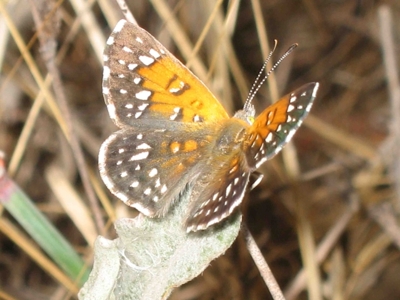Lange’s Metalmark Butterfly
The Lange’s Metalmark Butterfly (Apodemia mormo ssp. langei ) is a brightly colored, fragile, and highly endangered butterfly that has been protected by the Federal Endangered Species Act since 1976. The species is endemic to the Antioch Dunes in Contra Costa County, and the only known extant population today is found at the Antioch Dunes.

Lange’s Metalmark Butterfly. Photo © Liam O’Brien.
Between 50 to 100 years ago, the population size of the Lange’s metalmark butterfly at the Antioch Dunes is estimated to have been approximately 25,000 individuals. However, by 2006, the number had plummeted to a total of 45 adults. For the past five years, the number of adults observed in the wild has continued to remain at critically low levels. Surveys from 2009 to 2011 revealed an average population for the species of 35 individuals in the wild.
The sole food plant for the larval (caterpillar) stage of the butterfly is the naked-stemmed buckwheat (Eriogonum nudum ssp. auriculatum), which grows best in areas with good drainage. The health of the Lange’s Metalmark is entirely dependent on the population of naked-stemmed buckwheat, and there is a direct positive correlation between the population size of this plant and the population of the butterfly.
However, today the buckwheat is only found in a limited portion of the Antioch Dunes National Wildlife Refuge, and this remaining area is threatened with extirpation due to the prolific overgrowth of non-native, invasive plant species, none of which provide food for the butterfly’s caterpillar stage. Although the naked-stemmed buckwheat is not threatened with global extinction, the loss of this essential host plant at the Antioch Dunes National Wildlife Refuge will surely lead to the extinction of the Lange’s Metalmark Butterfly because of the species’ limited range.

Leave a Reply
Want to join the discussion?Feel free to contribute!